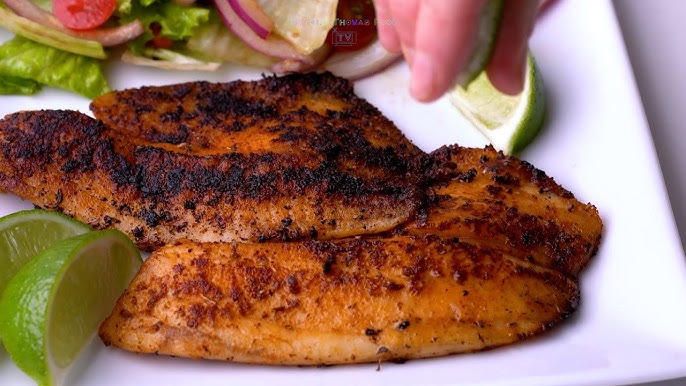Blackened Fish Recipe: Ever bitten into a piece of fish that’s spicy, smoky, crisp on the outside, yet tender and juicy on the inside? That, my friend, is the magic of blackened fish. If you’ve ever wanted to bring bold flavors to your dinner table without spending hours in the kitchen, this is the recipe you need in your life. Blackened fish isn’t just tasty—it’s also healthy, quick, and incredibly versatile. Whether you’re planning a weeknight dinner or trying to impress someone special, this dish hits the mark every time. Let’s dive right in.
What is Blackened Fish?
Blackened fish is a cooking technique that originated in Cajun cuisine, popularized by chef Paul Prudhomme. It involves coating the fish in a robust spice mix, then searing it in a very hot pan—usually cast iron—until the spices form a dark, charred crust. But don’t worry, it’s not “burned” in the bad way. That deep, dark coating is what gives the fish its unforgettable flavor. The high heat caramelizes the spices, creating that signature smoky depth. It’s spicy, savory, and full of character—kind of like grilling’s cooler cousin.
Why You’ll Love This Recipe
Here’s why blackened fish will become your new go-to:
- Quick & Easy – Ready in under 20 minutes from start to finish.
- Healthy – Packed with lean protein and healthy fats.
- Customizable – Works with different types of fish and seasoning levels.
- Restaurant-Quality at Home – Impress your guests or treat yourself.
- Perfect for Meal Prep – Stores and reheats well.
Think of it as the no-fuss gourmet dinner that doesn’t break your back (or your budget).
Best Types of Fish for Blackening
When choosing fish for blackening, texture matters more than anything.
Firm Fish Varieties
Here are some of the best options:
- Tilapia – Mild flavor and budget-friendly.
- Catfish – Traditional in Southern-style blackened recipes.
- Red Snapper – Holds up well to the high heat.
- Salmon – Rich and fatty; balances the bold spices perfectly.
- Mahi Mahi – Slightly sweet and firm.
- Halibut – Meaty and luxurious.
Flavor Pairings
If you love bold flavors, go for stronger-tasting fish like salmon or tuna. If you prefer something milder, tilapia or cod are great choices. Either way, the seasoning will do most of the heavy lifting.
Essential Ingredients You’ll Need
Let’s break this down into two parts: the seasoning and the rest.
Spices for Blackened Seasoning
You probably already have these in your pantry:
- Paprika (smoked or sweet)
- Garlic powder
- Onion powder
- Cayenne pepper
- Dried thyme
- Dried oregano
- Salt
- Black pepper
Fish and Other Key Components
- Fish fillets (skinless, about 4–6 oz each)
- Olive oil or melted butter (for searing)
- Fresh lemon juice (for serving)
- Optional: chopped parsley or green onions
Homemade Blackening Seasoning Mix
Skip the store-bought stuff. Here’s how to make your own:
Ingredients:
- 1 tablespoon smoked paprika
- 1 teaspoon cayenne pepper (adjust to taste)
- 1 teaspoon garlic powder
- 1 teaspoon onion powder
- 1 teaspoon dried thyme
- 1 teaspoon dried oregano
- 1 teaspoon salt
- ½ teaspoon black pepper
Instructions:
- Mix all the spices in a small bowl.
- Store leftovers in an airtight jar for up to 3 months.
You can also double or triple the batch if you want to keep it on hand for chicken or shrimp.
Fresh vs Frozen Fish – What Works Best?
Fresh is always ideal, but frozen works perfectly too—just make sure to fully thaw and pat dry before seasoning. Excess water can ruin that beautiful blackened crust. If you’re using frozen, place it in the fridge overnight or defrost it gently under cold running water.
Kitchen Tools You’ll Need
To get that signature blackened crust, these tools are your best friends:
- Cast iron skillet – Retains heat like a champ.
- Tongs or fish spatula – For flipping without breaking the fillets.
- Mixing bowl – For the seasoning.
- Paper towels – To dry the fish.
- Stovetop fan or open window – Things are gonna get smoky!
How to Prep the Fish Perfectly
Prepping is half the battle. Here’s how to get it right:
- Thaw the fish if frozen and bring it to room temperature (let it sit out for 10–15 minutes).
- Pat it dry—this is crucial. Use paper towels to soak up all the surface moisture.
- Brush both sides of the fish with melted butter or oil to help the seasoning stick and crisp up.
- Rub in the seasoning. Don’t just sprinkle it—press it into the fish for maximum flavor.
Step-by-Step Guide to Cooking Blackened Fish
Step 1: Pat the Fish Dry
Always start with dry fish. This is non-negotiable. Moisture causes the spices to steam instead of sear, leading to a soggy crust. So grab those paper towels and give each fillet a thorough blotting.
Step 2: Season Generously
Grab that homemade spice blend and get to work. You want a thick, even coating—don’t be shy. Press the seasoning into both sides of the fillet like you’re giving it a mini massage.
Step 3: Preheat Your Pan or Grill
Heat a cast iron skillet over medium-high heat for about 5 minutes until it’s smoking hot. Don’t add oil just yet. You want the pan hot enough to sizzle the second the fish hits it.
Step 4: Sear the Fish
Add a tablespoon of butter or oil to the pan and swirl it quickly. Lay the fish in the skillet and don’t touch it for 3–4 minutes. Let the crust form.
Step 5: Flip and Finish
Use a thin spatula or tongs to flip the fish carefully. Cook for another 2–4 minutes, depending on the thickness. The outside should be almost black and crispy, but the inside should still be moist and flaky.
How to Know When the Fish is Done
Cooking fish can feel intimidating, but here’s a simple trick: the fish should flake easily with a fork. That means it’s cooked through and ready to serve. The internal temperature should be around 135°F to 140°F if you want to be exact (use a meat thermometer if you have one).
Other signs your fish is perfectly cooked:
- The edges are crispy and dark.
- It’s opaque all the way through (no more translucent flesh).
- It breaks apart effortlessly with a fork.
Overcooking is the biggest mistake people make with blackened fish. If your fillets are thin, they’ll cook fast—so keep an eye on them and remove them from the pan as soon as they’re done.
Pro Tips for the Perfect Blackened Crust
Getting that crust just right is all about technique. Here are some game-changing tips:
- Use a HOT pan: You need high heat to char the spices without overcooking the fish inside.
- Don’t overcrowd the pan: Cook in batches if you need to. Too many fillets at once will cool down the skillet.
- Resist the urge to move the fish: Let it sit undisturbed so a proper crust can form.
- Butter = flavor + crust: Using a mix of butter and oil helps develop a richer, deeper color.
- Ventilate your kitchen: Seriously, this gets smoky. Open a window or turn on the fan.
Cooking is part science, part art—and this is one of those recipes where the technique makes all the difference.
Serving Suggestions
Blackened fish is super versatile. It’s just as delicious on a plate as it is in a taco. Here are a few serving ideas to make your meal pop:
- Over rice or quinoa with grilled veggies
- Fish tacos with cabbage slaw and chipotle mayo
- On a salad with avocado, corn, and lime vinaigrette
- Sandwiched in a toasted brioche bun with remoulade sauce
- Alongside mashed potatoes and sautéed green beans
Drizzle some fresh lemon juice on top right before serving—it adds brightness and cuts through the spice.
What to Serve With Blackened Fish
Need some sidekick dishes? Here’s a roundup of sides that pair beautifully with the bold flavors of blackened fish:
| Side Dish | Description |
|---|---|
| Cilantro Lime Rice | Bright and fragrant, balances out the spicy crust. |
| Grilled Corn Salad | Adds crunch and sweetness. |
| Coleslaw | Creamy slaw cools down the heat perfectly. |
| Roasted Potatoes | Crispy and hearty—a classic side for any fish dish. |
| Garlic Green Beans | A healthy, vibrant veggie to round out the plate. |
Mix and match based on your mood. Want to keep it light? Go for a fresh salad. Craving comfort? Mashed potatoes or mac and cheese hit the spot.
How to Store and Reheat Leftovers
Blackened fish stores surprisingly well. If you made extra or want to meal prep, here’s what to do:
To Store:
- Let the fish cool completely.
- Wrap it tightly in foil or plastic wrap.
- Store in an airtight container in the fridge for up to 3 days.
To Reheat:
- Gently warm in a skillet over medium heat for 2–3 minutes per side.
- Or, reheat in a 300°F oven for about 10 minutes.
- Avoid microwaving—this can make the fish rubbery and dry.
Pro tip: Use leftover blackened fish in tacos, wraps, or salads for an easy second meal!
Variations to Try
Want to switch things up? The blackening technique works with more than just fish.
Blackened Salmon
Rich and fatty, salmon stands up beautifully to the heat and bold spice. Just cook it a little longer than white fish.
Blackened Shrimp
A quick and easy twist. Shrimp take only 1–2 minutes per side to cook, making them perfect for weeknight meals or appetizers.
Blackened Chicken
Don’t eat seafood? No problem. Pound chicken breasts thin, season, and cook the same way. You’ll get that same crispy, spicy crust on juicy meat.
This method is like your new favorite pair of jeans—fits everything and always looks good.
Common Mistakes to Avoid
Even seasoned cooks can mess up blackened fish if they’re not careful. Here’s what to watch out for:
- Not using a hot enough pan – No sizzle = no crust.
- Using wet fish – Moisture kills the sear.
- Overcooking the fish – Dry, chewy fish is a no-go.
- Not enough seasoning – You need a thick coating for flavor and texture.
- Flipping too soon – Let the crust form before you move the fish.
Stay mindful of these and your fish will come out picture-perfect every time.
Nutritional Breakdown
Here’s a general estimate per serving (based on tilapia, 6 oz):
| Nutrient | Amount |
|---|---|
| Calories | 220–250 |
| Protein | 35g |
| Fat | 8–10g |
| Carbohydrates | 1–2g |
| Fiber | 0g |
| Sodium | Varies based on seasoning |
Low in carbs, high in protein, and packed with flavor—this dish is a solid choice for anyone on keto, low-carb, or high-protein diets.
FAQs about Blackened Fish Recipe
1. Is blackened fish spicy?
It can be! The spice level depends on how much cayenne pepper you use. Start with less and add more to suit your taste.
2. Can I use a non-stick pan instead of cast iron?
You can, but cast iron gives the best sear. Non-stick pans won’t reach the same high heat safely.
3. Can I make this recipe dairy-free?
Absolutely. Just use oil instead of butter to coat the fish before seasoning.
4. What’s the difference between grilled and blackened fish?
Grilled fish is cooked over open flames; blackened fish is seared in a hot skillet with bold spices. Both are delicious—just different techniques.
5. Can I bake blackened fish instead of searing it?
Yes, you can bake it at 425°F for 10–15 minutes, but you’ll miss out on that charred crust. For full flavor, pan-searing is the way to go.
Conclusion
Blackened fish isn’t just a dish—it’s a full-blown flavor experience. With a killer crust, a smoky kick, and endless pairing possibilities, it’s a weeknight dinner that feels like a restaurant-quality meal. Once you try it, you’ll wonder how you ever lived without it.
Whether you’re keeping it classic or putting your own spin on it with salmon, shrimp, or chicken, this blackened fish recipe is a must-have in your kitchen arsenal. Now go grab that skillet and make something amazing tonight.



